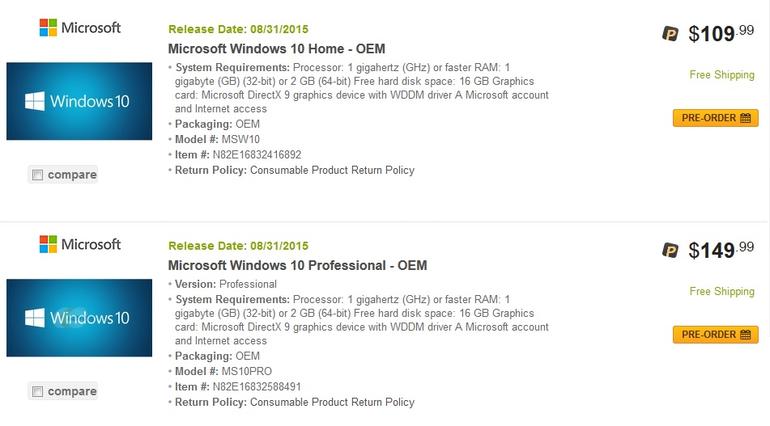Microsoft Windows 10 release date and OEM pricing leaked
In 2012, online retailer Newegg had apparently “jumped the gun” on Windows 8, by listing the operating system’s OEM pricing and pre-order availability, before any formal announcement by Microsoft.
History repeats itself, with the same online retailer now publishing two listings for the upcoming operating system’s OEM version: Windows 10 Home Edition and Professional.

The OEM Caveat
Consumers should curb their enthusiasm before pre-ordering windows 10 OEM.
OEM versions of Windows are typically destined to system builders looking to resell the license, along with systems built for customers. Also, the rules for proper use of these licenses are up to Microsoft, and individual use after purchase may or may not be allowed, depending on what Microsoft puts into the fine print.
According to a support document for OEM builders, the rules for Windows 8.1 OEM licensing seem to be pretty clear:
“Q. Can I use OEM system builder software that I purchase and install myself?
A. If you are building a PC for your personal use or installing an additional operating system in a virtual machine, you will need to purchase Windows 8 software or a Microsoft retail version of Windows 8.1 software. Windows 8.1 system builder software does not permit personal use, and is intended only for preinstallation on customer systems that will be sold to end users.“
(Source: http://www.microsoft.com/OEM/en/Pages/support-faq.aspx#fbid=tMMad4r2OES)
What is an OEM license?
As previously mentioned, OEM licensing is meant for system builders. Examples of OEM versions of operating systems, are those found in laptops, tablets and smartphones, where branding is visible in different key areas of the user interface. For instance in the form of a default wallpaper, preinstalled apps, or other UI customizations allowed by the software manufacturer.
When purchasing a new laptop, or desktop system, the installation disk that comes with the system is also branded accordingly, and often carries a notice for the consumer, warning that installation of the included software is only allowed on that system.
In some systems, or devices, such as smartphones or tablets, separate installation media is not provided at all, and any type of support on the operating system may occur either online, or through the manufacturer of the device on which an OEM operating system is installed.
While the 8/31 release date may be as accurate as it can be, the $109, and $149 price tags are most likely quite below what the consumers retail price will be just as Windows 8.1 and Windows 7 OEM versions were.
The good news is, most consumers who already own Windows 7 and Windows 8.1, will probably won’t worry about that, as most users will get a free upgrade.